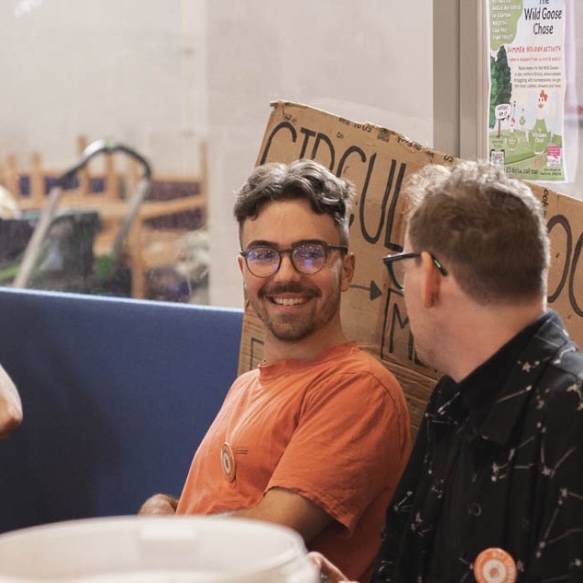SEE SOIL SOUNDS: Exploring the Hidden Life of Bristol’s Soil
- Alex Montgomery
- May 7
- 4 min read
Updated: Oct 13
Soil is the foundation of life on Earth but most of us never stop to think about it.
In fact, the word soil still carries negative meanings in everyday language: “soiled,” “dirt,” “filthy.”
Yet beneath our feet lies one of the most complex and vital ecosystems on the planet a living, breathing network that sustains every meal we eat.
That’s what inspired SEE SOIL SOUNDS, my doctoral research and public engagement project based in Bristol. My aim is simple: to change how people see, hear, and feel soil.

Why I Started This Research
As part of my PhD with the UK Food Systems Centre for Doctoral Training, I’ve been exploring one big question:
How can we change public perceptions of soil to inspire better food waste management, healthier soils, and stronger communities?
When I began my academic journey, I’ll admit I didn’t find soil exciting.
During my undergraduate degree, I even avoided soil-related modules.
But over the past decade, my perspective has completely changed.
Working in food education, sustainability, and community composting opened my eyes to how everything, from our health, food, and climate, depends on the health of our soil.
Now, through my research and through Generation Soil CIC, I’m trying to share that realisation with others.

The Problem: Soil Is Out of Sight, Out of Mind
Modern life has distanced most people from the land.
Cities have paved over nature, and our waste systems operate far away from where we live.
Studies show that when people think of soil, they associate it with dirt rather than life (Henry & Cring, 2013).
This perception gap matters because disconnected societies tend to mismanage their soils, treating them as disposable rather than regenerative.
At the same time, urbanisation and industrial food systems have created record levels of food waste and rapid soil degradation.

Healthy, living soil, rich in microorganisms, organic matter, and fungi, is disappearing at an alarming rate.
Despite progress in soil science, public awareness hasn’t caught up.
That’s where communication, creativity, and sensory engagement come in.

SEE SOIL SOUNDS: Bringing Soil to Life
To shift public perception, my project focuses on one key principle:
👉 People connect with what they can sense.
SEE SOIL SOUNDS is a sensory exploration of Bristol’s living soils.
Participants are invited to experience soil through every sense:
Sound: Listening to the subtle crackles and vibrations recorded by contact microphones in soil.
Sight: Observing soil microbes under microscopes and watching compost teeming with life.
Touch: Feeling the difference between dead, compacted soil and soft, living soil.
Smell: Breathing in the earthy scent of healthy soil, caused by actinomycetes, a group of beneficial bacteria.
Taste: Enjoying local food grown in Bristol soil, closing the sensory loop between ground and plate.
Each workshop transforms something invisible and ignored into something tangible and meaningful.
Why Soil Awareness Matters for Bristol
Bristol is a city with a deep environmental conscience, yet most food waste still leaves the city.
That means nutrients that could regenerate local soils are lost from the cycle.
Projects like the Bristol Living Compost Project show that it’s possible to create hyperlocal food waste systems that turn scraps into living compost.
But to scale that impact, we need a cultural shift.
We need people to see soil not as waste, but as life.
By blending science, art, and sensory experience, SEE SOIL SOUNDS aims to make that shift happen, one workshop, one soundscape, one handful of soil at a time.

The Academic Framework Behind It
While SEE SOIL SOUNDS is creative, it’s built on a strong academic foundation.
I use a multi-level behavioural model to analyse how awareness, behaviour, and systems interact.
The methods include:
Sensory workshops: to engage participants directly.
Surveys (before and after): to measure shifts in understanding and perception.
Interviews and thematic analysis: to explore how sensory experiences change behaviour.
This approach is grounded in critical realism, acknowledging that while we can’t know everything about soil systems, we can understand how perception influences action.
It’s the first research project of its kind to measure the effect of soil awareness campaigns through academic evaluation.
Learning from Global Examples
Cities like Surabaya, Indonesia, have shown what’s possible when public engagement meets practical action.
Surabaya reduced landfill waste by over 30% through a citywide composting programme, run through schools and neighbourhood hubs.
If Bristol can follow a similar path, combining community composting with creative education, we can regenerate both our soils and our social fabric.
SEE SOIL SOUNDS draws from these global lessons while grounding them in Bristol’s local culture of creativity and collaboration.

Why Sensory Soil Experiences Work
Traditional education relies heavily on words and numbers. But soil is something you need to feel.
When people touch living soil, they often describe it as “warm,” “alive,” or “comforting.”
When they hear its sounds under the microscope, they realise it’s an ecosystem, not an object.
These sensory experiences bypass technical barriers and go straight to emotion, building empathy for soil life.
That empathy is what drives behaviour change, from composting to regenerative gardening.
A Regenerative Future
Soil connects everything: our food, climate, and wellbeing.
Through SEE SOIL SOUNDS, I hope to spark a new way of seeing it:
As something living, dynamic, and worth protecting.
If we can listen to soil, literally and figuratively, we might start to act in ways that help it thrive again.




Comments